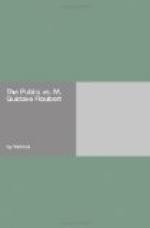What is the outline he has chosen, the subject he has taken, and how has he treated it? My client belongs to any of the schools, whose names I have just learned in the Attorney’s speech. Heaven knows he belongs to the realistic school, in that he occupies himself with the reality of things. He belongs to the psychological school, in the sense that it is not material things which engage him, but human sentiment and the development of the passions wherever the human being is placed. He belongs to the romantic school less perhaps than to any other, because, if romanticism appears in his book, as does realism, it appears only in some ironical expressions here and there, which the public attorney has taken seriously. What M. Flaubert especially wished was to take a subject of study from real life, creating from it some true types of the middle class, arriving finally at some useful result. Yes, what has most occupied my client in the studies to which he has devoted himself, is precisely this useful aim, followed out in putting upon the scene three or four personages from actual society, living in the conditions of real life, and presenting them to the eyes of the reader in a true picture of what is met with very often in the world.
The Prosecuting Attorney, summing up his opinion of Madame Bovary, has said:
“The second title of this work might be: The Story of the Adulteries of a Provincial Woman.”
I protest vigorously against this title. This alone, had I not listened to your speech from beginning to end, would prove to me the prejudice in which you are firmly bound. No! the second title of this work is not: The Story of the Adulteries of a Provincial Woman; it is, if it is absolutely necessary to have a second title: the story of the education too often met with in the provinces; the story of the perils to which such an education leads; the story of degradation, of dishonesty, of suicide, considered as a consequence of a first fault, and a fault led up to through wrong-doing, by which a young woman is often carried away. It is the story of an education, and the deplorable life of which such an education is often the preface. This is what M. Flaubert desired to paint, and not the adulteries of a woman of the provinces. You will see this at once on reading the incriminated book.
Now, the prosecuting attorney perceives in all this, and through it all, a lascivious colour. If it were possible to take the number of lines of the book which he has cut out, and put parallel to them other lines that he has left, we should have a total proportion of about one to five hundred; and you would see that this proportion of one to five hundred was in no way of a lascivious colour; it exists only under the conditions of being cut out and commented upon.
Now, what has M. Flaubert desired to paint? First, education given to a woman which is above the conditions to which she was born—something that too often happens among us, it must be confessed. Then, the mixture of discordant elements that are thus produced in the intelligence of the woman; and then when marriage comes, especially if the marriage is not in accordance with the education, but rather with the conditions under which the woman was born, the author explains all these facts which occur in the situation that he depicts.




